|
1.
CENTRAL/ WEST AFRICA
Buyers hesitate amid global economic downturn
The market situation in West Africa remained sluggish
during October 2008. China and India were buying at very
cautious levels as buyers were gauging how quickly the
economic downturn in Europe might affect global timber
manufacturing. Banking problems in the US and UK have
hit real estate sales and building developments probably
much harder in these countries than elsewhere as
borrowing and lending has become more difficult in these
markets.
Prices for logs and lumber were unchanged from earlier in
the month, although it is probable some sales have been
made at a discount when sellers needed to clear stock or
were trying to maintain cash flow.
Production in West Africa was low due to workforce
reduction in the sector and closure of facilities. Heavy
rains in most countries were also curtailing logging and
transport of logs to the mills and ports. Business with
Europe was very slow. Importers were keen to reduce
stocks, as their own sales were lower. Historically, the
European winter has brought lower consumption even
without the current global economic problems. Forecasts
for the economic situation in the UK and Continental
Europe show low or no growth for the next 12 to 24
months. It does not seem possible that there will be any
prompt upturn in the consumption of timber and timber
products in the short or medium-term.
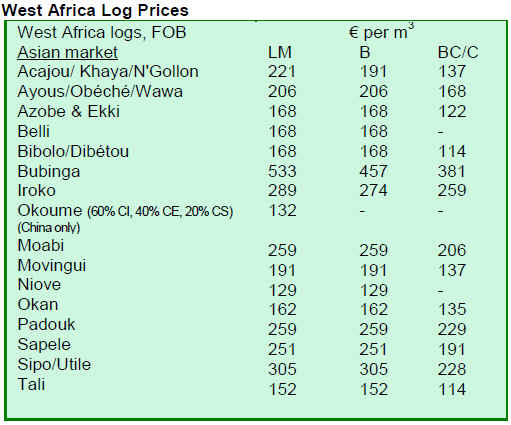
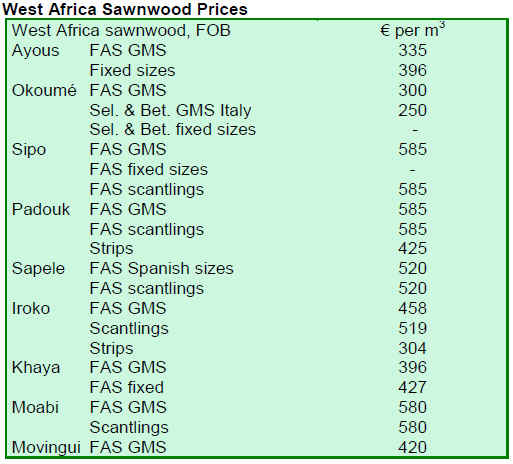
2. GHANA
GIFEX
highlights value-added products from the
region
The 12th Ghana International Furniture and Wood Industry
Exhibition (GIFEX 2008) was held from 17-26 October
2008 at the Ghana International Trade Fair Center in
Accra, Ghana, under the theme ¡®100 Years of Forestry and
50 Years of Industrialization in Ghana ¨C Networking
Partnerships for Sustainable Development¡¯. GIFEX 2008,
which was organized by the Forestry Commission (FC)
under the auspices of the Ministry of Lands, Forestry and
Mines and in collaboration with the Association of Ghana
Industries (AGI), highlighted the roles played by the FC
and AGI in promoting the industrialization of natural
resources, which has enabled Ghana¡¯s economy to grow.
At the opening ceremonies, President J. A. Kufour¡¯s
speech emphasized that the government had improved
forest governance in the country and hoped this would
ultimately support the industry to source and process only
legal timber for domestic and export markets. He also said
that Ghana was undertaking a special initiative on timber
plantation development, which would cover an area of
over 140,000 hectares.
Mr. Alhassan Attah, Executive Director of the Timber
Industry Development Division (TIDD), stated that the
reactivation of the GIFEX event after a ten year period had
the potential to make Ghana a hub for high value-added
wood products in the sub-region. Attah explained that the
intention of the FC was to make GIFEX a biennial affair in
Ghana. He noted that this year¡¯s exhibition was broad and
included new participants from sectors such as information
technology, banking, shipping and insurance, architecture
and design.
The Chairman of the GIFEX 2008 Council, Professor Nii
Ashie Kotey, said the FC saw GIFEX as a potential
vehicle for promoting value-added processing, which
could position Ghana as a hub for furniture and joinery in
the ECOWAS sub-region. He also said that Ghana had
recently entered into a voluntary partnership agreement
(VPA) with the EU, under which measures were
developed on the use of lesser used species and bamboo
and rattan. The Director of Business Development
Services of AGI, Mr. Seth Twum-Akwaboah, said GIFEX
was a good opportunity for members of AGI to sell their
products and promote their brand to a wider market.
The exhibition was divided into two zones. The first zone
showcased Ghanaian-made furnishing, imported
furnishing, service industries, IT and communication
industries and wood crafts. The second zone featured
themes ranging from climate change to opportunities for
investment in the forestry sector. The TIDD of the FC also
showcased a stand on bamboo to promote the
breakthroughs Ghana has made in its search for alternative
wood sources for the furniture industry.
FC gets tough on defaulting companies
As reported in the Daily Graphic, the FC has suspended
and revoked the licenses and permits for harvesting and
exporting timber products by all timber companies
indebted to the FC as at 30 September 2008. The statement
issued by the FC authorizes officials of the Commission to
stop all harvesting and exporting activities of such
companies currently operating in the forests and at the
ports, to ensure they do not add to their existing debts. The
FC also warned that all existing debts as of the above date
would be subject to a minimum interest charge set by the
Bank of Ghana and in accordance with regulation 25 (1) of
the Timber Management Resource Regulations of 1998
(L.I. 1649). Companies failing to make full payments of
their debts, including the related interest charge on or
before 15 October 2008 will be published in the media
under the title ¡®Timber Companies not in Good Standing¡¯
and appropriate actions will be taken.
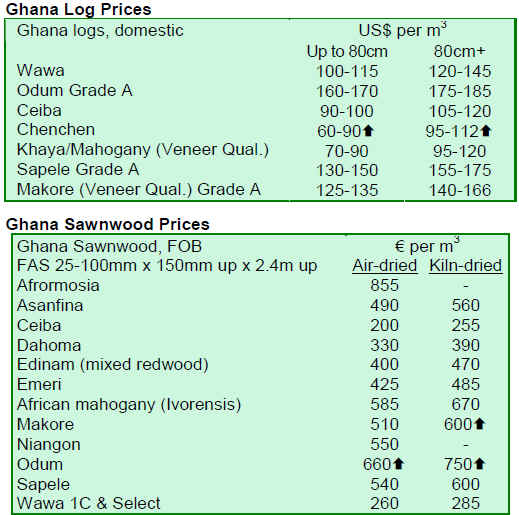

3.
MALAYSIA
Sabah pushes for expansion of value-added wood
products
State Minister for Resource Development and Information
Technology, Datuk Dr. Yee Moh Chai, encouraged
workers to enter the commodities and plantation sectors,
due to the state¡¯s increasing focus on value-added wood
products to develop the national economy. He noted that
many workers would be needed to assist with the
production of value-added activities in the 689 sawmills
operating in Sabah. Yee noted that at present the
contribution of value-added exports from Sabah was
negligible, but that these products could obtain higher
prices and benefits in the markets than primary processed
products. Changing the focus of production to valueadding
activities would enable Sabah to make a greater
contribution to the national economy in the form of export
revenue and employment.
Sabah accounts for 16% of Malaysia¡¯s total exports, with
the main wood exports from the state being plywood,
sawnwood and timber. Malaysia¡¯s wood products exports
netted RM22.76 billion in 2007, with furniture and
plywood being the main exports, accounting for RM6.72
billion and RM6.27 billion, respectively. The main
markets for Malaysia¡¯s wood products were the US,
Europe, Japan and China.
Malaysian state invests in PNG timber
The Malaysian state of Kedah has bought a 70% share in
MAS Incorporated, a Malaysian-owned timber business
operating in Papua New Guinea. The deal was negotiated
by Kedah state government¡¯s subsidiary, Kedah
Corporation Berhad (KedahCorp). MAS Incorporated,
which has been operating in PNG for the last 15 years,
holds the right to log 200,000 hectares of forest in PNG.
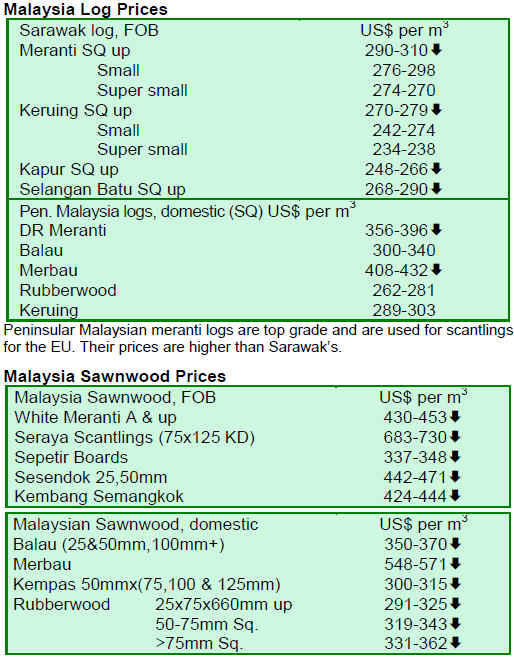
4.
INDONESIA
Furniture transactions dominate Trade Expo
Antara News reported that the 23rd Indonesia Trade Expo
was dominated by furniture transactions, with one
exhibitor earning about USD1 million on the first day
alone. Buyers of furniture were predominantly Spanish,
Greek, Italian and British, and represented 64% of all
deals during the first two days of the Expo, 21 and 22
October 2008. The Expo organizers hoped to obtain
USD220 million in transactions, a 10% increase from the
previous Expo. Over 4,600 buyers from over 63 countries,
including the US, Brazil, UAE, Australia, Japan, Nigeria
and Malaysia, were expected to attend the third day of the
event.
Wood-based bioenergy highlighted at Asia Pacific
Forum
A number of high-level officials highlighted the benefits
of using wood-based bioenergy at the Asia Pacific Forum
in Jakarta, Indonesia, according to Antara News. Forestry
Minister MS Kaban expressed hope that the Forum would
yield positive recommendations or formulas for the
development of wood-based bioenergy in response to the
need for renewable energy sources in many countries. He
noted that wood-waste used as bioenergy could also help
offset carbon emissions and hoped that wood-waste
bioenergy prices could eventually compete with the price
of fossil fuels.
ITTO Executive Director, Emmanuel Ze Meka, said that
the development of wood-waste as an alternative energy
source would help create new jobs and industries to
produce bio-energy within the forest sector. Timber
industries in rural areas were expected to particularly
benefit from the development of bio-energy, helping to
improve the economy in local villages, build the local
workforce and create new energy sources.
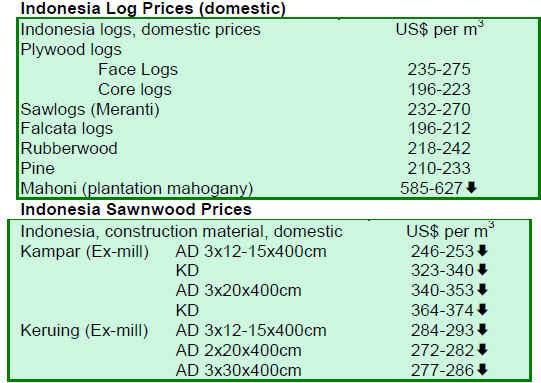
5.
MYANMAR
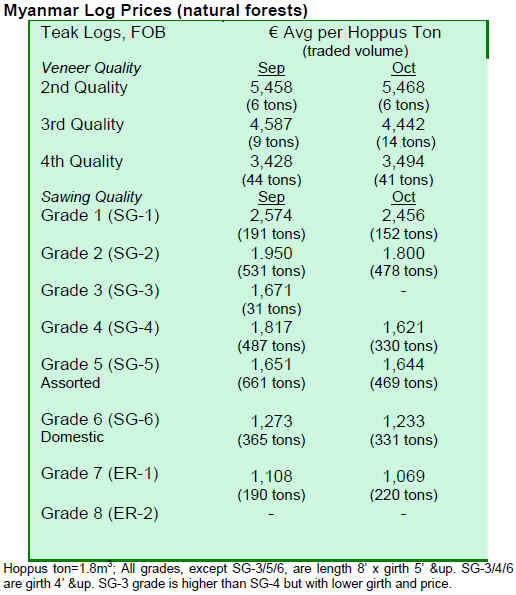

6.
BRAZIL
US dollar continues to impact Brazilian furniture
industry
The Jornal do Com¨¦rcio noted that the strong value of the
US dollar against the Brazilian real continued to impact
the Brazilian furniture sector. According to the
Association of Furniture Companies of Rio Grande do Sul
(MOVERGS), some furniture manufacturers expected to
recover losses due to the rising dollar. However, due to the
global economic downturn and waning demand for
Brazilian wood products in the US, furniture companies
were exercising caution when undertaking business
negotiations to avoid future loss. Rising production costs
were expected to make it difficult for the sector to recover
losses. As production costs rose, suppliers have been
demanding higher prices in response to the rising costs of
materials, although foreign customers have been asking
for discounts on furniture purchases. The market in Rio
Grande do Sul was hoping to recover through the
engagement of new customers in non-traditional export
destinations. Nevertheless, Rio Grande do Sul has had an
overall advantage in the current economic crisis, since
about 86% of its production has been sold in the domestic
market.
Market weakens for Par¨¢¡¯s native timber species
The Secretariat of the Environment (SEMA) of the State
of Par¨¢ has estimated that the market of native timber
species in the state has fallen, reported O Eco/Amazônia.
In 2007, Par¨¢ produced a total volume of 9 million m³, of
which 7 million m³ were authorized and considered legal
by the Brazilian Institute of Environment and Renewable
Natural Resource (IBAMA). In 2008, logging permits
issued by SEMA were issued at 3.2 million m³ to
concentrate on the production volume of legally-operating
companies. Illegal companies continued logging between
1.5 and 2 million m³, valued at about BRL2 billion. This
year, SEMA has seized about 140,000 m³ of illegal logs.
There will be more legal (authorized) logging in 2009 as a
result of Brazil¡¯s Forest Concession Plan (PAOF). By the
end of 2009, the goal of the Brazilian Forest Service (SFB)
is to approve 4 million hectares of natural forest for
concessions, representing 2% of total registered public
forests. The objective of the PAOF is to reduce illegal
logging and offer opportunities for sustainable timber
production through the allocation of forest concessions
and the promotion of community forest management. The
PAOF was initiated after the Minister of Environment
signed an agreement on legal timber with timber producers
in the state of Para.
In 2009, forest concessions plans will be developed as part
of the PAOF. The state of Par¨¢ recently presented its
PAOF, which indicated that 1.3 million ha of state forest
would be available for forest concessions in 2009. The
neighboring state of Amapa¡¯s PAOF will make available
2.3 million ha for forest concessions from its state forest
area.
Brazil¡¯s exports slip further in September 2008
Brazil¡¯s wood products exports (except pulp and paper)
dropped nearly 31% from USD393.3 million in September
2007 to USD273 million in September 2008. The charts
below show the volume and value of Brazil¡¯s exports for
September 2008 compared to the same month a year
earlier:
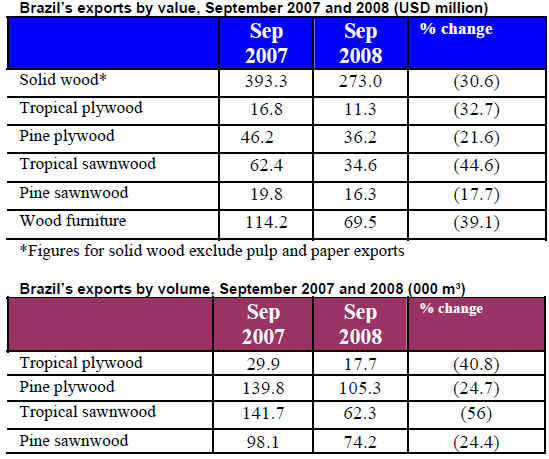
Inspection operations reveal illegal exports of Brazil
nut timber
Results from IBAMA¡¯s Operation Guardian of Amazonia
of revealed that Rio Grande do Sul has become a major
distribution center of illegally logged Brazil nut timber,
reported Zero Hora/EcoDebate. Brazil nut timber has been
subject to logging bans since 1994 and a favorite species
of manufacturers of products used in civil construction due
to its length, softness and durability.
IBAMA¡¯s investigations focused on consumers of wood
products instead of loggers. The recent inspections
provided valuable information on illegal timber by
checking receipts, hearing violators¡¯ testimonies and
scrutinizing the Document of Forest Origin (DOF). In Rio
Grande do Sul, the operation seized 3,300 m³ of timber,
70% of which was Brazil nut timber. Most of the timber
was sent to Buenos Aires and then onwards to Europe. The
timber was shipped by truck from Northern Brazil to the
southernmost state in an attempt to thwart inspection.
The violators believed driving long distances to transport
timber would decrease the likelihood that inspectors at the
destination site would have information and knowledge of
the Amazonian species. IBAMA admitted that it was often
not easy to identify the origin of timber and in many cases
it was necessary to send a sample to a lab to identify the
species. In many cases, the violators falsified the DOF,
writing down a timber name authorized for logging. After
crossing the Brazilian boarder, timber went to a wholesale
distributor in Buenos Aires or Montevideo and was
shipped with new documentation onward to Europe.
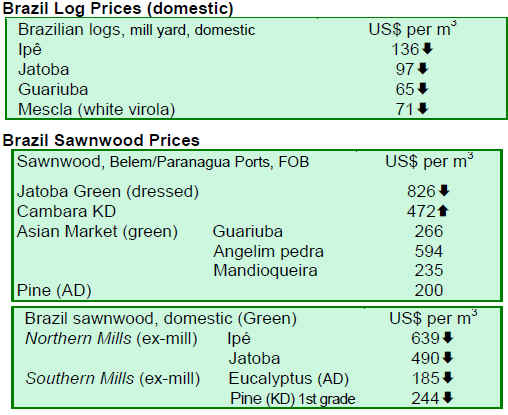
7.
PERU
Peru¡¯s 2008 wood products exports grow 12%
According to the Export Association of Peru (ADEX),
Peru¡¯s wood products exports from January to August
2008 grew 12% to USD158 million in 2008 from USD141
million during the same period in 2007. However, exports
in August 2008 were USD3.12 million less than in August
2007. The volume of exports to the US and Mexican
markets in August 2008 fell in contrast to a rise in exports
to the Chinese market.
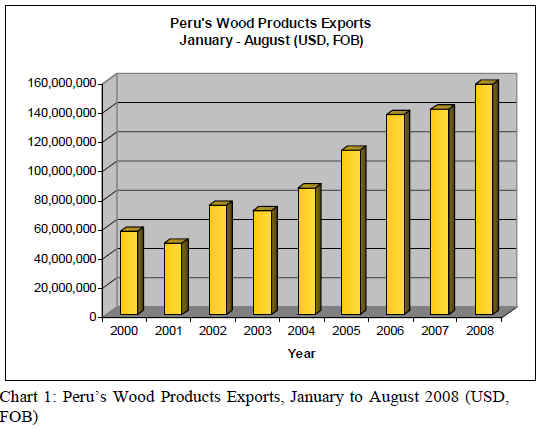
The sectors showing significant growth from January to
August 2008 were: building products (107%); veneer and
plywood (37%); and semi-manufactured products (27%).
Furniture and parts showed a 20% fall in export value
during the same period. Sawnwood exports showed the
largest jump during the period, representing 46% of sector
exports. Exports from January to August 2008 were
USD73.34 million, compared to USD72.61 million for the
same period in 2007. The main markets for sawnwood
were Mexico, US and China.
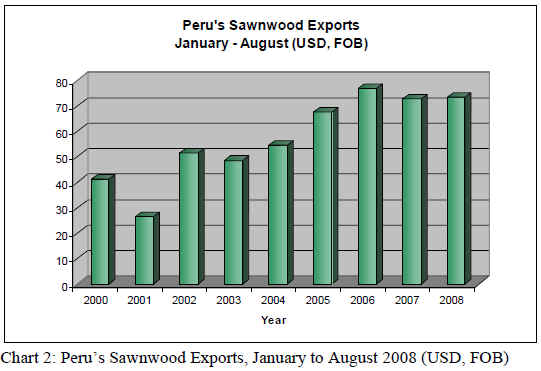
Semi-manufactured products represented 29% of wood
sector exports. Exports in January to August 2008 were
valued at 46.5 million, while exports for the same period
in 2007 were valued at USD36.6 million, a 27.3% rise.
Exports of semi-manufactured products in August 2008
rose by USD1.18 million from August 2007 levels. The
gains were largely due to the progressive growth in
exports such as decking, for which China had been the
main market, accounting for 71% of exports.
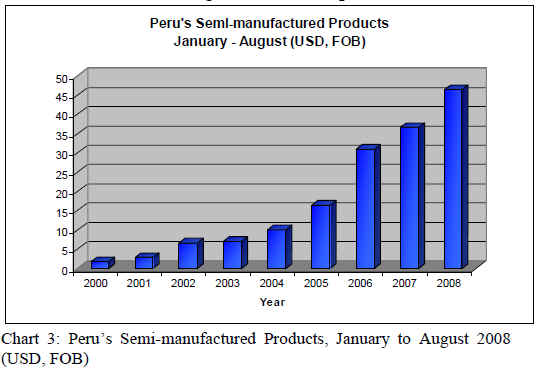
Veneer and plywood exports for the January to August
2008 period were USD20 million, a 37% jump from the
same period in 2007. Exports from the sub-sector showed
Mexico as the main market for Peru¡¯s exports (90%),
followed by Venezuela.
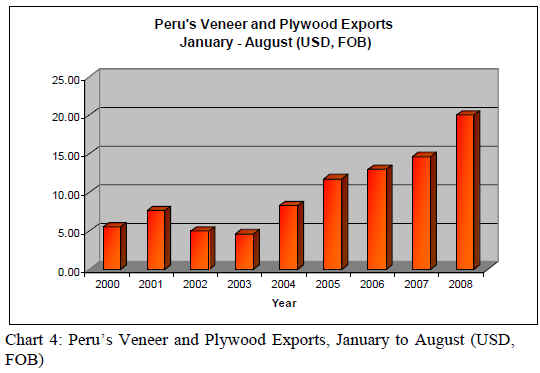
Furniture exports netted USD9.3 million during the period,
a 20.25% fall from the same period in 2007. The main
market for these products was the US (59%) followed by
Italy (22%).
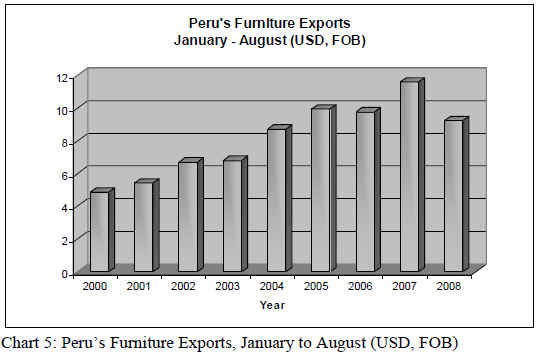
From January to August 2008, Peru¡¯s exports were
concentrated in three markets, which represented 85% of
total wood products exports. Mexico represented 37.8% of
exports in the sector, with exports growing nearly 42%
from the previous period, followed by China with nearly
26%. The US was the third destination market, receiving
about 22% of exports.
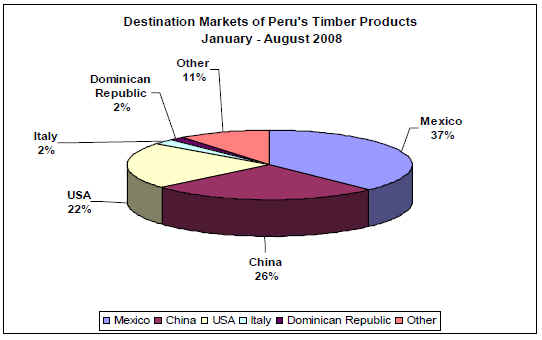
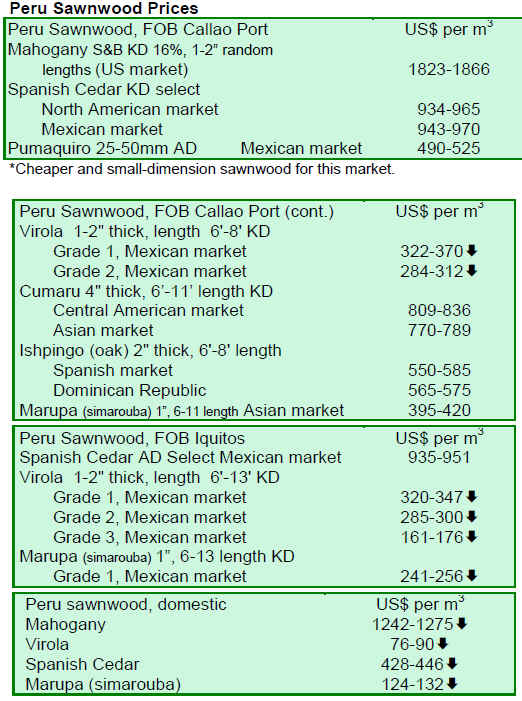
8. BOLIVIA
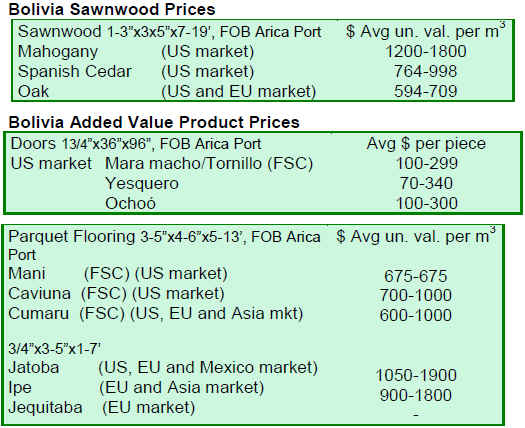
9. MEXICO
Mexico steps up use of certification to combat illegal
logging
Illegal harvesting of timber has been a significant problem
in Mexico¡¯s forest sector. In 2005, fifteen critical forest
zones accounted for 60% of illegal cut areas at the national
level, according to data from the Federal Office of
Environmental Protection (PROFEPA). As a result,
Mexico has focused on growing their certified forest area
to prevent illegal harvesting. Mexico has been using
certification as a tool against illegal logging and to
contribute to the sustainability of multiple natural
resources. The implementation of new certification
techniques will be supported and supervised by various
institutions created by the government.
Mexican government promotes green purchasing
In 2007, Mexico issued a decree revising the Law of
Acquisitions, Rentals and Services of the Public Sector,
which indicated that wood, furniture and other office
equipment were required to be from sustainably managed
sources. The Mexican government is promoting green
purchasing to facilitate the implementation of forest
certification and chain of custody in the country. It also is
currently setting an example by using furniture from
certified wood sources, thereby contributing to
environmental sustainability. Elements of Mexico¡¯s
national system of certification and chain of custody
include: preventative technical audits undertaken by
CONAFOR; environmental audits managed by
PROFEPA; and certification of sound forest management
practices monitored by the Forest Stewardship Council.
10.
GUYANA
Guyana sawnwood trends show solid performance
The Guyana Forestry Commission has given close
attention to the sawnwood market, since it now accounts
for 47% of the country¡¯s forest sector¡¯s total earnings from
January to September 2008. It is the single most exported
product in this period. Overall, there have been increases
in both the volume and value of sawnwood exports for
2008 as compared to the corresponding period in 2007.
The general price level of sawnwood has had an impact on
the resulting trend, with an overall increase seen in the
period for this product category. The overall increases in
both export volume and value have been attributed to
growing demand for Guyana¡¯s sawnwood, especially in
the Caribbean and Asia Pacific region. Below is a
summary of the comparative performance over the first
nine months of 2008.
|